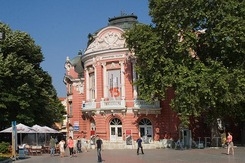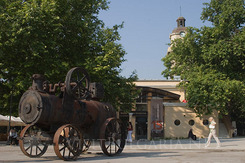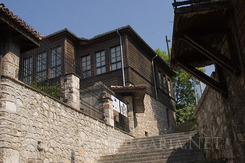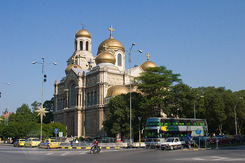Over one billion euro has been invested in the wellness and spa industry in Bulgaria over the past more...
| Search | Hotels / Accommodation | Vacations | Tours & Trips | Rent A Car | Transport | Flights | Conferences | Press Centre | Yachting |
- Hotels & Accommodation in Varna





- Grand Hotel London
- Dallas Residence
- Dimyat Grand Hotel




- Golden Tulip Varna hotel
- Aqua Hotel
- Capitol Hotel
- Divesta hotel
- Panorama Hotel



- Odessos Hotel
- Art Hotel
- Best Western Park Hotel
- Best Western Prima Hotel
- Briz 2 Hotel
- Cherno More Hotel
- Citius Hotel
- City Mark Hotel
- Dionis Hotel

- Duchess Hotel
- Hi Hotel
- Impala Hotel
- Niagara hotel
- Oceanic Casino and Hotel
- Park Hotel Persey
- Plaza Hotel
- Reverence Hotel
- Seapark Homes Neshkov
- Splendid hotel
- Terra Hotel
- Ventura Hotel Complex
- Victoria Hotel



- Classic House Hotel
- Margarita Hotel
- mOdus Hotel
- Orbita Hotel
- Perfect Hotel

- Sorbona Hotel

- Nearby hotels



- Family Hotel Albizia


- Ovchaga Complex

- Sherba Eco Complex
- Apartments in Varna
- STUDIO
- Bohemi Business Studio
- Bohemi Lux Studio
- 1 BEDROOM
- Bohemi VIP apartment
- Varna Guide
- Early booking in Varna
- All inclusive in Varna
- Last minute in Varna
- Hotels in Varna
- Apartments in Varna
- Villas in Varna
- Rural houses in Varna
- Vacations in Varna
- Transport To Varna
- Tours in Varna
- Conferences in Varna
- Articles on Varna
- News From Varna
- Map of Varna
- Aladzha Monastery
- Weather Forecast
- Varna Guide
- Varna Airport
- Romantic Yacht Dinner
- Holidays in Bulgaria
- All inclusive
- Beach
- Birdwatching
- Golf
- Health
- History
- Hunting
- Monasteries/ Religious
- Mountain biking
- Prom
- Rural
- Ski
- Spa & Wellness
- Trekking
- Water sports
- Weekend breaks
- Wine
- Conference
- Children Holidays
- Yachting
- Events
- Type of accommodation
- Hotels
- Apartments
- Villas
- Rural houses
- Destinations
- Aheloy
- Ahtopol
- Albena
- Apriltsi
- Arbanassi
- Asparuhovo
- Assenovgrad
- Bachkovo Monastery
- Balchik
- Bankya
- Bansko
- Banya (Karlovo)
- Banya (Razlog)
- Batak
- Beklemeto
- Belchin Bani
- Beli Iskar
- Belogradchik
- Berkovitsa
- Blagoevgrad
- Bodrost
- Bojichen
- Borovets
- Botevgrad
- Bourgas
- Bozhentsi
- Bratsigovo
- Brestovitsa
- Buzludja
- Byala
- Chepelare
- Cherepish Monastery
- Chernomorets
- Chiflik
- Devin
- Dimitrovgrad
- Dobarsko
- Dobrich
- Dobrinishte
- Dolna Banya
- Dospat
- Dryanovo
- Dupnitsa
- Dyuni
- Elena
- Elenite
- Elhovo
- Gabrovo
- Gela
- Golden Sands
- Gorna Oryahovitsa
- Gotse Delchev
- Govedartsi
- Grand Hotel Varna
- Harmanli
- Haskovo
- Haskovo Mineral Baths
- Hissarya
- Ivaylovgrad
- Kalofer
- Kamchia
- Kamen Bryag
- Kardjali
- Karlovo
- Kavarna
- Kazanlak
- Kiten
- Kom
- Koprivshtitsa
- Kosharitsa
- Kostenets
- Kostenkovtsi
- Kotel
- Kovatchevitsa
- Kranevo
- Kresna
- Kulinoto
- Kyustendil
- Lom
- Lovech
- Lozenets
- Lukovit
- Lyaskovets
- Madara
- Malko Tarnovo
- Malyovitsa
- Melnik
- Mezdra
- Momchilovtsi
- Montana
- Narechen Baths
- Near Golden Sands
- Nessebar
- Obzor
- Ognyanovo
- Osogovo
- Pamporovo
- Panagyurishte
- Panichishte
- Parshevitsa
- Pavel Banya
- Pavlikeni
- Pazardjik
- Pernik
- Petrich
- Pirdop
- Pleven
- Pliska
- Plovdiv
- Pomorie
- Pravets
- Preslav
- Primorsko
- Ravda
- Razgrad
- Razlog
- Ribaritsa
- Rila Monastery
- Riviera
- Rousse
- Rusalka
- Samokov
- Sandanski
- Sapareva Banya
- Semkovo
- Sevlievo
- Shabla
- Shipka
- Shipkovo
- Shiroka Laka
- Shkorpilovtsi
- Shoumen
- Silistra
- Sinemorets
- Sliven
- Smolyan
- Sofia
- Sopot
- Sozopol
- Srebarna
- St. Constantine & Elena
- Stara Zagora
- Starozagorski Baths
- Sunny Beach
- Sunny Day
- Sveti Vlas
- Svilengrad
- Svishtov
- Targovishte
- Teteven
- Tran
- Trigrad
- Troyan
- Tryavna
- Tsarevo
- Tsigov Chark
- Uzana
- Varna
- Varshets
- Veliko Tarnovo
- Velingrad
- Vidin
- Vitosha
- Voneshta Voda
- Vratsa
- Vratsata Gorge
- Yagoda
- Yakoruda
- Yambol
- Zlatitsa
- Zlatograd
- Bulgaria Guide
- General information
- Bulgarian Monasteries
- SPA Bulgaria
- The Black sea
- History
- Geography
- Maps
- Weather
- Airports in Bulgaria
- Webcams
- Forums
- Mountains in Bulgaria
- The Balkan Mountain Range
- Rila Mountain
- Pirin Mountain
- The Rodope Mountain
- Vitosha Mountain
- Travel Arrangements
- Visit Bulgaria
- Visa Requierments
- Choose Destination
- Flights to Bulgaria
- Transport in Bulgaria
- Advice
- Currency
- Official Holidays
Subscribe to newsletters to receive our hottest offers:
| Home > Varna > News |
Varna City - Summer Capital of Bulgaria
News.bg

Varna is the largest city on the Bulgarian Black Sea Coast, 3rd largest in Bulgaria after the capital of Sofia and Plovdiv city (Central Bulgaria).
Varna is 91st-largest in the EU, with a population of 357,752.
The city is considered as the summer capital of Bulgaria, major tourist destination, seaport, and headquarters of the Bulgarian Navy and merchant marine.
Varna is also the centre of Varna Province and Bulgaria's North-Eastern planning region comprising the provinces of Dobrich, Shumen, Silistra(on the Danube River), and Varna.
 Geography:
Geography:
Varna occupies an area of 320,000 sq km situated on verdant terraces descending from the calcareous Frangen Plateau (height 356 m) along the Varna Bay of the Black Sea, the elongated Lake Varna, and two waterways bridged by the Asparuhov most.
The urban area has in excess of 20 km of sand beaches and abounds in thermal mineral water sources.
It enjoys a mild continental climate influenced by the proximity to the sea with long.
The city lies 470 km north-east of Sofia.
 Varna is accessible by air (Varna International Airport), sea (Port of Varna Cruise Terminal), railroad (Central Train Station), and automobile. Major roads include European routes E70 and E87 and national motorways A-2 and A-5; there are bus lines to many Bulgarian and European cities from two bus terminals.
Varna is accessible by air (Varna International Airport), sea (Port of Varna Cruise Terminal), railroad (Central Train Station), and automobile. Major roads include European routes E70 and E87 and national motorways A-2 and A-5; there are bus lines to many Bulgarian and European cities from two bus terminals.
History:
Varna is among Europe's oldest cities. Miletians founded the apoikia (trading colony) of Odessos in 570 BCE at the site of an earlier Thracian settlement.
The name Odessos was pre-Greek, perhaps of Carian origin.
Long before the Thracians populated the area by 1200 BCE, several prehistoric settlements best known for the eneolithic necropolis, eponymous site of the Varna culture and the world's oldest large find of gold artifacts existed within modern city limits.
Odessus was an early Christian centre, as testified by ruins of early basilicas, monasteries.
Theophanes the Confessor first mentioned the name Varna, as the city came to be known with the Slavic conquest of the Balkans in the 6th-7th century.
 In 681, Asparukh, the founder of the First Bulgarian Empire, routed an army of Constantine IV north of the Danube delta and reached the so-called Varna near Odessos. Recent scholarship has suggested that the first Bulgarian capital was perhaps located around Varna before it moved to Pliska.
In 681, Asparukh, the founder of the First Bulgarian Empire, routed an army of Constantine IV north of the Danube delta and reached the so-called Varna near Odessos. Recent scholarship has suggested that the first Bulgarian capital was perhaps located around Varna before it moved to Pliska.
By the late 13th and 14th century, it had turned into a thriving commercial hub frequented by Genoese, Venetian and Ragusan merchant ships.
Shipbuilding developed in the Kamchiya river mouth.
14th-century Italian portolan charts showed Varna as perhaps the most important seaport between Constantinople and the Danube delta;
 In 1866, the first railroad in Bulgarian lands connected Varna with the port of Rousse on the Danube, linking the Ottoman capital Istanbul with Central Europe; for a few years, the Orient Express ran through that route.
In 1866, the first railroad in Bulgarian lands connected Varna with the port of Rousse on the Danube, linking the Ottoman capital Istanbul with Central Europe; for a few years, the Orient Express ran through that route.
With the national liberation in 1878, the city, which numbered 26 thousand inhabitants, was ceded to Bulgaria by the Treaty of Berlin and Russian troops entered it on July 27.
Economy:
The economy is service-based, with 61% of net revenue generated in trade and tourism, 16% in manufacturing, 14% in transportation and communications, and 6% in construction.
The city is the easternmost destination of Pan-European transport corridor 8 and is closely connected to corridors 7 and 9 via Rousse.
Varna forms the Varna-Devnya Industrial Complex, home to some of the largest chemical, power generating and manufacturing plants in Bulgaria, including the sites of the two largest cash privatization deals in recent history.
Tourism is of foremost importance, with the suburban beachfront resorts of Golden Sands, Holiday Club Riviera, Sunny Day, Constantine and Helena, and others with a total capacity of over 60,000 beds (2006), attracting millions of visitors each year (4.74 million in 2006, 3.99 million of which international tourists).
Real estate is booming, with some of the highest prices in the nation, often surpassing Sofia. Economically, Varna is considered among the best-performing Bulgarian cities; unemployment, at 2.34%, is 4 times lower, and per capita income is higher than the national average (2007). Many Bulgarians regard Varna as a boom town; some, including from Sofia and Plovdiv, but mostly from Dobrich and the greater region, are relocating.
Population:
The first population data dates back to the mid-1600s when the town was thought to have about 4,000 inhabitants. After the Liberation in 1878, the first population census in 1881 found 24,555 people in Varna.
In 1992, the population was 307,915 according to the census.
Currently, Varna is still officially (according to NSI and GRAO) the 3rd-largest city in Bulgaria including the local government, show it as the second largest one with perhaps up to 520,000 inhabitants, with a daily population of more than 600,000; and in the high summer months, 800,000 or even up to to one million.
In 2006, Varna was one of the few cities in Bulgaria with a positive population growth; the number of people who were born in the city is more than the number of deaths. The majority of the inhabitants are ethnic Bulgarians (85.3%). Turks traditionally used to rank second (8.1%).
Sights:
City landmarks include: Varna Archaeological Museum, exhibiting the Gold of Varna, the Roman Baths, the Battle of Varna Park Museum, the Naval Museum in the Italianate Villa Assareto displaying the museum ship Drazki torpedo boat, the Museum of Ethnography in an Ottoman-period.
Another interesting places to be seen in Varna are: Sea Garden (Varna) - the oldest and perhaps largest park in town containing an open-air theatre, an aquarium, a dolphinarium, the Nicolaus Copernicus Observatory and Planetarium, the Museum of Natural History, a terrarium, a zoo, an alpineum, and other attractions.The Garden is a national monument of landscape architecture.
The waterfront promenade is lined by a string of beach clubs offering a vibrant scene of rock, hip-hop, Bulgarian and American-style pop, techno, and chalga.
It enjoys a nationwide reputation for its rock and hip-hop artists.
Additionally, the 2.05 km long, 50 m high Asparuhov most bridge is a popular spot for bungee jumping. Outside the city are the Euxinograd palace, park and winery, the University of Sofia Botanical Garden (Ecopark Varna), the Pobiti Kamani rock phenomenon, and the medieval cave monastery, Aladzha.
Today, very little of this legacy remains; the downtown was rebuilt by the nascent Bulgarian middle class in late 19th and early 20th century in Western style with local interpretations of Neo-Renaissance, Neo-Baroque, Neoclassicism, Art Nouveau and Art Deco (many of those buildings, whose ownership was restored after 1989, underwent extensive renovations).
Beach resorts were designed mostly in a sleek modern style, which was somewhat lost in their recent more lavish renovations.
Varna's vineyards, dating back perhaps to antiquity and stretching for miles around, started turning from mostly rural grounds dotted with small vili.
The beach resorts were rebuilt and expanded, fortunately without being as heavily overdeveloped as were other tourist destinations on the Bulgarian Black Sea coast, and their lush greenery was mostly preserved. New office buildings started reshaping the old city centre.
Varna museums you should visit are: Varna Archaeological Museum, Naval Museum, Roman Baths, Aladzha Monastery, Battle of Varna Park Museum, National Revival Museum, History of Varna Museum, Museum of Ethnography, Bulgar Settlement of Phanagoriaethnographical village, Aquarium, Nicolaus Copernicus Observatory and Planetarium, Naval Academy, Planetarium, Terrarium , Zoo, Dolphinarium and many others.
In Varna take place a lot of national and international festivals and competitions: Varna Summer" International Music Festival, "Varna Summer" International Jazz Festival, European Music Festival, "Discovery" International Pop Festival ,International Theatre Festival, "Love is Folly" Film Festival, Crafts fair.
Twin cities of Varna are: Aalborg (Denmark), Dordrecht (Netherlands), Kharkiv (Ukraine), Aqaba (Jordan), Odessa (Ukraine), Malmo (Sweden), Turku (Finland), Miami (United States), Rostock (Germany), Novorossiysk (Russia), Pireus (Greece), Memphis (United States), Amsterdam (Netherlands), Washington (England), Karlsruhe (Germany), Boston (United States).

















